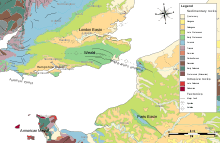Weald–Artois Anticline

The Weald–Artois anticline is a large anticline, a geological structure running between the regions of the Weald in southern England and the Artois in northeastern France. The fold formed during the Alpine orogeny, from the late Oligocene to middle Miocene as an uplifted form of the Weald basin through inversion of the basin. The folding resulted in uplift of about 180 metres (590 ft),[1] though concurrent erosion may have substantially reduced the actual height of the resulting chalk ridges.
As is the case with all anticlines, older rock strata are found in the core of the structure. These are in this case Upper Jurassic and Lower Cretaceous strata. The eastern part of the ridge, the Weald of Kent, Sussex and Surrey has been greatly eroded, with the presumed chalk surface removed to expose older, Lower Cretaceous rocks (Wealden Group) and a small area of Upper Jurassic Purbeck Beds.[2] On the French side of the English Channel more Upper Jurassic rocks crop out in a small area around Boulogne-sur-Mer and Desvres.[3] At the flanks of the anticline outcrops of the (younger) Upper Cretaceous Chalk occur. The chalk survives as a rim of inward-facing escarpments, forming the North Downs and South Downs. The Chalk forms characteristic white cliffs on both sides of the English Channel, an example are the white cliffs of Dover.
Formation of the Strait of Dover
The Strait of Dover is geologically speaking a very young feature, which cuts through the much older Weald–Artois Anticline. The anticline continues uninterrupted in the subsurface of the Strait of Dover and English Channel.
During the Pleistocene an ice sheet blocked the flow of rivers including the Thames and Rhine to the North Sea, resulting in a large proglacial lake to the northeast of the ridge. To the southwest, low-lying land connected the island that is now Great Britain to continental Europe. Two overtoppings of this ridge severed this peninsular connection.
- The first glacial lake outburst flood occurred approximately 425,000 years ago, resulting in a waterfall of up to a million cubic meters per second that gouged out the Straits of Dover and caused much sudden outwash flood scouring (as shown by braided channels and diamond-shaped islands in sonar surveys) in low-lying land where the English Channel is now.
- The second, which may have been larger than the first, occurred approximately 225,000 years ago and finally severed the slender peninsula.[4][5]
During the most recent glacial period, lowering of sea levels joined the British Isles once more to the continental mainland of Europe.
References
- ↑ Tertiary Rivers: Neogene (Miocene and Pliocene), Cambridge Quaternary, Cambridge University
- ↑ Gallois R.W. & Edmunds M.A. (4th Ed 1965), The Wealden District, British Regional Geology series, British Geological Survey, ISBN 0-11-884078-9
- ↑ Carte Géologique de la France, BRGM, Orléans
- ↑ Schiermeier, Quirin (2007-07-18). "The megaflood that made Britain an island". Nature. Retrieved 2008-01-31.
- ↑ Marks, Paul (2007-07-18). "Dam-busting "megaflood" made Britain an island". New Scientist. Retrieved 2008-01-31.